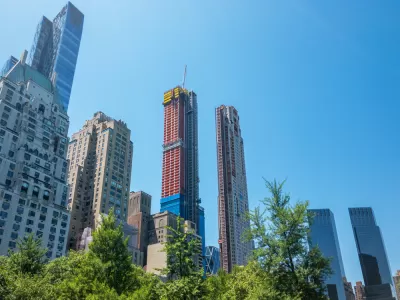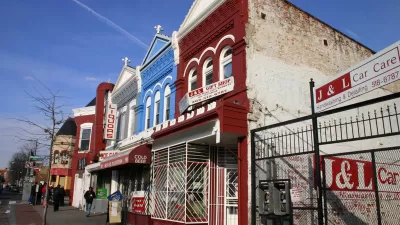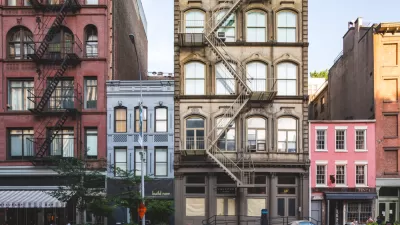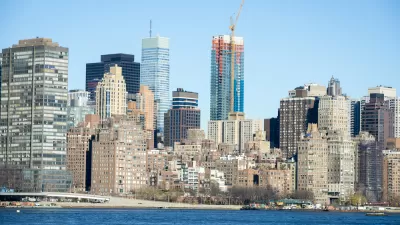New York City's groundbreaking Mandatory Inclusionary Housing Program will turn five years old in March. While some call for the program to be eliminated, others defend it.

New York City's Mandatory Inclusionary Housing (MIH) program recently inspired a back-and-forth debate in the pages of City Limits.
Sandy Hornick and Lynn Ellsworth both write articles on the subject of New York City's Mandatory Inclusionary Housing (MIH) program, adopted by the New York City Council in 2016 and championed by Mayor Bill de Blasio as a component of the Housing New York Plan.
Ellsworth writes first, describing the MIH program as a failure for falling short of its lofty targets of affordable housing creation. Among a list of failures, Ellsworth includes: "The MIH policy doesn’t work. As of December 2019, only 2,000 'affordable' units of the promised 80,000 have actually been built under the policy. Surely that is a sign of failure." Instead of building affordable housing, argues Ellsworth, MIH "[floods] upzoned neighborhoods with luxury housing, mostly in the form of towers, creating a kind of gentrification on steroids that displaces existing residents and the small businesses that served them."
Ellsworth proposes six policy alternatives to MIH, including incentives for accessory dwelling units, community housing trusts, building on city-owned land, and single room occupancy buildings, among other prescriptions.
Hornick follows with a rejoinder, immediately taking exception to the fundamental issue of how many affordable housing units have been delivered by the MIH program.
Ms. Ellsworth asserts that the city promised that the MIH program would deliver 80,000 affordable apartments but only delivered 2,000. No such promise was ever made. The promise of 80,000 new affordable dwellings was made in 2014 but relates to the total new construction anticipated over 10 years in the Mayor’s Housing New York Plan from all of the city’s programs. At the end of fiscal year 2020—seven years into the program—the city had financed just over 50,000 new units. That’s a little off the pace needed to get to 80,000 newly-built homes in 10 years but comfortably within reach of exceeding 70,000. Falling short of the goal by 10 percent or so may not be a point to brag about but adding over 7,000 new affordable apartments a year is a pretty remarkable accomplishment.
According to Hornick, it's not market-rate housing development that causes gentrification and rising housing costs, as suggested by Ellsworth, but its lack. "In New York City—for at least the past four decades—the shortfall in housing production has resulted in a market pushing up the price of existing housing to the substantial detriment of the less affluent."
As noted by Hornick, the MIH program is only applicable in neighborhoods that have been rezoned since the implementation MIH, which until recently hadn't included any of the more affluent neighborhoods in New York City. The ongoing process of rezoning NoHo and SoHo in Manhattan, along with Gowanus in Brooklyn, will change that dynamic.
FULL STORY: Opinion: In Defense of Mandatory Inclusionary Housing

Study: Maui’s Plan to Convert Vacation Rentals to Long-Term Housing Could Cause Nearly $1 Billion Economic Loss
The plan would reduce visitor accommodation by 25,% resulting in 1,900 jobs lost.

North Texas Transit Leaders Tout Benefits of TOD for Growing Region
At a summit focused on transit-oriented development, policymakers discussed how North Texas’ expanded light rail system can serve as a tool for economic growth.

Using Old Oil and Gas Wells for Green Energy Storage
Penn State researchers have found that repurposing abandoned oil and gas wells for geothermal-assisted compressed-air energy storage can boost efficiency, reduce environmental risks, and support clean energy and job transitions.

Private Donations Propel Early Restoration of Palisades Playground
Los Angeles has secured over $1.3 million in private funding to restore the Pacific Palisades playground months ahead of schedule, creating a modern, accessible space that supports community healing after recent wildfires.

From Blight to Benefit: Early Results From California’s Equitable Cleanup Program
The Equitable Community Revitalization Grant (ECRG) program is reshaping brownfield redevelopment by prioritizing projects in low-income and environmental justice communities, emphasizing equity, transparency, and community benefits.

Planting Relief: Tackling Las Vegas Heat One Tree at a Time
Nevada Plants, a Las Vegas-based nonprofit, is combating the city’s extreme urban heat by giving away trees to residents in underserved neighborhoods, promoting shade, sustainability, and community health.
Urban Design for Planners 1: Software Tools
This six-course series explores essential urban design concepts using open source software and equips planners with the tools they need to participate fully in the urban design process.
Planning for Universal Design
Learn the tools for implementing Universal Design in planning regulations.
Ascent Environmental
Borough of Carlisle
Institute for Housing and Urban Development Studies (IHS)
City of Grandview
Harvard GSD Executive Education
Toledo-Lucas County Plan Commissions
Salt Lake City
NYU Wagner Graduate School of Public Service





























